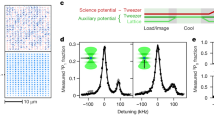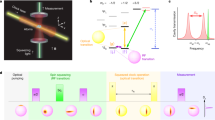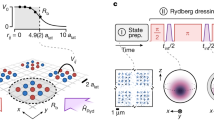Abstract
The generation of long-lived entanglement in optical atomic clocks is one of the main goals of quantum metrology. Arrays of neutral atoms, where Rydberg-based interactions may generate entanglement between individually controlled and resolved atoms, constitute a promising quantum platform to achieve this. Here we leverage the programmable state preparation afforded by optical tweezers and the efficient strong confinement of a three-dimensional optical lattice to prepare an ensemble of strontium-atom pairs in their motional ground state. We engineer global single-qubit gates on the optical clock transition and two-qubit entangling gates via adiabatic Rydberg dressing, enabling the generation of Bell states with a state-preparation-and-measurement-corrected fidelity of 92.8(2.0)% (87.1(1.6)% without state-preparation-and-measurement correction). For use in quantum metrology, it is furthermore critical that the resulting entanglement be long lived; we find that the coherence of the Bell state has a lifetime of 4.2(6) s via parity correlations and simultaneous comparisons between entangled and unentangled ensembles. Such long-lived Bell states can be useful for enhancing metrological stability and bandwidth. In the future, atomic rearrangement will enable the implementation of many-qubit gates and cluster state generation, as well as explorations of the transverse field Ising model.
This is a preview of subscription content, access via your institution
Access options
Access Nature and 54 other Nature Portfolio journals
Get Nature+, our best-value online-access subscription
$29.99 / 30 days
cancel any time
Subscribe to this journal
Receive 12 print issues and online access
$209.00 per year
only $17.42 per issue
Buy this article
- Purchase on Springer Link
- Instant access to full article PDF
Prices may be subject to local taxes which are calculated during checkout




Similar content being viewed by others
Data availability
The experimental data presented in this manuscript are available upon request and through Zenodo (https://doi.org/10.5281/zenodo.6626065).
References
Kitagawa, M. & Ueda, M. Squeezed spin states. Phys. Rev. A 47, 5138 (1993).
Wineland, D. J., Bollinger, J. J., Itano, W. M. & Heinzen, D. Squeezed atomic states and projection noise in spectroscopy. Phys. Rev. A 50, 67 (1994).
Sackett, C. A. et al. Experimental entanglement of four particles. Nature 404, 256–259 (2000).
Esteve, J., Gross, C., Weller, A., Giovanazzi, S. & Oberthaler, M. Squeezing and entanglement in a Bose–Einstein condensate. Nature 455, 1216–1219 (2008).
Burd, S. et al. Quantum amplification of mechanical oscillator motion. Science 364, 1163–1165 (2019).
Tse, M. E. et al. Quantum-enhanced advanced LIGO detectors in the era of gravitational-wave astronomy. Phys. Rev. Lett. 123, 231107 (2019).
Megidish, E., Broz, J., Greene, N. & Häffner, H. Improved test of local Lorentz invariance from a deterministic preparation of entangled states. Phys. Rev. Lett. 122, 123605 (2019).
Backes, K. et al. A quantum enhanced search for dark matter axions. Nature 590, 238–242 (2021).
Ushijima, I., Takamoto, M., Das, M., Ohkubo, T. & Katori, H. Cryogenic optical lattice clocks. Nat. Photon. 9, 185–189 (2015).
McGrew, W. et al. Atomic clock performance enabling geodesy below the centimetre level. Nature 564, 87–90 (2018).
Marti, G. E. et al. Imaging optical frequencies with 100 μHz precision and 1.1 μm resolution. Phys. Rev. Lett. 120, 103201 (2018).
Origlia, S. et al. Towards an optical clock for space: compact, high-performance optical lattice clock based on bosonic atoms. Phys. Rev. A 98, 053443 (2018).
Oelker, E. et al. Demonstration of 4.8 × 10−17 stability at 1 s for two independent optical clocks. Nat. Photon. 13, 714–719 (2019).
Brewer, S. M. et al. 27Al+ quantum-logic clock with a systematic uncertainty below 10−18. Phys. Rev. Lett. 123, 033201 (2019).
Mehlstäubler, T. E., Grosche, G., Lisdat, C., Schmidt, P. O. & Denker, H. Atomic clocks for geodesy. Rep. Prog. Phys. 81, 064401 (2018).
Takamoto, M. et al. Test of general relativity by a pair of transportable optical lattice clocks. Nat. Photon. 14, 411–415 (2020).
Kolkowitz, S. et al. Gravitational wave detection with optical lattice atomic clocks. Phys. Rev. D 94, 124043 (2016).
Hu, L., Poli, N., Salvi, L. & Tino, G. M. Atom interferometry with the Sr optical clock transition. Phys. Rev. Lett. 119, 263601 (2017).
Abe, M. et al. Matter-wave atomic gradiometer interferometric sensor (MAGIS-100). Quantum Sci. Technol. 6, 044003 (2021).
Safronova, M. et al. Search for new physics with atoms and molecules. Rev. Mod. Phys. 90, 025008 (2018).
Leroux, I. D., Schleier-Smith, M. H. & Vuletić, V. Implementation of cavity squeezing of a collective atomic spin. Phys. Rev. Lett. 104, 073602 (2010).
Gil, L., Mukherjee, R., Bridge, E., Jones, M. & Pohl, T. Spin squeezing in a Rydberg lattice clock. Phys. Rev. Lett. 112, 103601 (2014).
Strobel, H. et al. Fisher information and entanglement of non-Gaussian spin states. Science 345, 424–427 (2014).
Zeiher, J. et al. Many-body interferometry of a Rydberg-dressed spin lattice. Nat. Phys. 12, 1095–1099 (2016).
Cox, K. C., Greve, G. P., Weiner, J. M. & Thompson, J. K. Deterministic squeezed states with collective measurements and feedback. Phys. Rev. Lett. 116, 093602 (2016).
Engelsen, N. J., Hosten, O., Krishnakumar, R. & Kasevich, M. A. Engineering spin-squeezed states for quantum-enhanced atom interferometry. In 2016 Conference on Lasers and Electro-Optics (CLEO) 1–2 (IEEE, 2016).
Pedrozo-Peñafiel, E. et al. Entanglement on an optical atomic-clock transition. Nature 588, 414–418 (2020).
Pogorelov, I. et al. Compact ion-trap quantum computing demonstrator. PRX Quantum 2, 020343 (2021).
Nichol, B. et al. A quantum network of entangled optical atomic clocks. Preprint at https://arxiv.org/abs/2111.10336 (2021).
Tóth, G. & Apellaniz, I. Quantum metrology from a quantum information science perspective. J. Phys. A: Math. Theor. 47, 424006 (2014).
Kessler, E. M., Lovchinsky, I., Sushkov, A. O. & Lukin, M. D. Quantum error correction for metrology. Phys. Rev. Lett. 112, 150802 (2014).
Zhou, S., Zhang, M., Preskill, J. & Jiang, L. Achieving the Heisenberg limit in quantum metrology using quantum error correction. Nat. Commun. 9, 78 (2018).
Kaubruegger, R., Vasilyev, D. V., Schulte, M., Hammerer, K. & Zoller, P. Quantum variational optimization of Ramsey interferometry and atomic clocks. Phys. Rev. X 11, 041045 (2021).
Shettell, N., Munro, W. J., Markham, D. & Nemoto, K. Practical limits of error correction for quantum metrology. New J. Phys. 23, 043038 (2021).
Marciniak, C. D. et al. Optimal metrology with programmable quantum sensors. Nature 603, 604–609 (2022).
Borregaard, J. & Sørensen, A. S. Near-Heisenberg-limited atomic clocks in the presence of decoherence. Phys. Rev. Lett. 111, 090801 (2013).
Pezzè, L. & Smerzi, A. Heisenberg-limited noisy atomic clock using a hybrid coherent and squeezed state protocol. Phys. Rev. Lett. 125, 210503 (2020).
Norcia, M. A. et al. Seconds-scale coherence on an optical clock transition in a tweezer array. Science 366, 93–97 (2019).
Madjarov, I. S. et al. An atomic-array optical clock with single-atom readout. Phys. Rev. X 9, 041052 (2019).
Young, A. W. et al. Half-minute-scale atomic coherence and high relative stability in a tweezer clock. Nature 588, 408–413 (2020).
Scholl, P. et al. Quantum simulation of 2D antiferromagnets with hundreds of Rydberg atoms. Nature 595, 233–238 (2021).
Ebadi, S. et al. Quantum phases of matter on a 256-atom programmable quantum simulator. Nature 595, 227–232 (2021).
Levine, H. et al. Parallel implementation of high-fidelity multiqubit gates with neutral atoms. Phys. Rev. Lett. 123, 170503 (2019).
Graham, T. et al. Rydberg-mediated entanglement in a two-dimensional neutral atom qubit array. Phys. Rev. Lett. 123, 230501 (2019).
Madjarov, I. S. et al. High-fidelity entanglement and detection of alkaline-earth Rydberg atoms. Nat. Phys. 16, 857–861 (2020).
Ma, S. et al. Universal gate operations on nuclear spin qubits in an optical tweezer array of 171Yb atoms. Phys. Rev. X 12, 021028 (2022).
Wilk, T. et al. Entanglement of two individual neutral atoms using Rydberg blockade. Phys. Rev. Lett. 104, 010502 (2010).
Isenhower, L. et al. Demonstration of a neutral atom controlled-NOT quantum gate. Phys. Rev. Lett. 104, 010503 (2010).
Leibfried, D. et al. Experimental demonstration of a robust, high-fidelity geometric two ion-qubit phase gate. Nature 422, 412–415 (2003).
Kirchmair, G. et al. High-fidelity entanglement of 43Ca+ hyperfine clock states. Phys. Rev. A 79, 020304 (2009).
Ballance, C., Harty, T., Linke, N., Sepiol, M. & Lucas, D. High-fidelity quantum logic gates using trapped-ion hyperfine qubits. Phys. Rev. Lett. 117, 060504 (2016).
Gaebler, J. P. et al. High-fidelity universal gate set for 9Be+ ion qubits. Phys. Rev. Lett. 117, 060505 (2016).
Shapira, Y., Shaniv, R., Manovitz, T., Akerman, N. & Ozeri, R. Robust entanglement gates for trapped-ion qubits. Phys. Rev. Lett. 121, 180502 (2018).
Mitra, A. et al. Robust Mølmer-Sørensen gate for neutral atoms using rapid adiabatic Rydberg dressing. Phys. Rev. A 101, 030301 (2020).
Kessler, E. M. et al. Heisenberg-limited atom clocks based on entangled qubits. Phys. Rev. Lett. 112, 190403 (2014).
Chou, C. W., Hume, D. B., Koelemeij, J. C. J., Wineland, D. J. & Rosenband, T. Frequency comparison of two high-accuracy Al+ optical clocks. Phys. Rev. Lett. 104, 070802 (2010).
Khazali, M., Lau, H. W., Humeniuk, A. & Simon, C. Large energy superpositions via Rydberg dressing. Phys. Rev. A 94, 023408 (2016).
Davis, E., Bentsen, G. & Schleier-Smith, M. Approaching the Heisenberg limit without single-particle detection. Phys. Rev. Lett. 116, 053601 (2016).
Hosten, O., Krishnakumar, R., Engelsen, N. J. & Kasevich, M. A. Quantum phase magnification. Science 352, 1552–1555 (2016).
Schulte, M., Martínez-Lahuerta, V. J., Scharnagl, M. S. & Hammerer, K. Ramsey interferometry with generalized one-axis twisting echoes. Quantum 4, 268 (2020).
Briegel, H. J., Browne, D. E., Dür, W., Raussendorf, R. & Van den Nest, M. Measurement-based quantum computation. Nat. Phys. 5, 19–26 (2009).
Martin, M. J. et al. A Mølmer-Sørensen gate with Rydberg-dressed atoms. Preprint at https://arxiv.org/abs/2111.14677 (2021).
Norcia, M. A., Young, A. W. & Kaufman, A. M. Microscopic control and detection of ultracold strontium in optical-tweezer arrays. Phys. Rev. X 8, 041054 (2018).
Jaksch, D. et al. Fast quantum gates for neutral atoms. Phys. Rev. Lett. 85, 2208 (2000).
Acknowledgements
We acknowledge J. Ye and his lab, particularly D. Kedar, for the operation and provision of the silicon-crystalline-cavity-stabilized clock laser and helpful conversations. We thank I. Deutsch, A. M. Rey, C. Sanner and A. Cao for fruitful discussions and feedback on the manuscript. A.M.K. acknowledges support from ARO grant no. W911NF-19-1-0223, AFOSR grant no. FA9550-19-1-0275, DOE Quantum System Accelerator (QSA) grant no. 7565477+, NSF QSEnSE QLCI-2016244, NSF JILA-PFC PHY 1734006 and NIST. N.S. acknowledges support from the NRC research associateship program. W.J.E. acknowledges support from the NDSEG. M.J.M. was supported by the Laboratory Directed Research and Development program of Los Alamos National Laboratory under project nos. 20190494ER and 20200015ER.
Author information
Authors and Affiliations
Contributions
The experiment was designed and built by N.S., A.W.Y., W.J.E. and A.M.K. N.S., A.W.Y. and W.J.E. operated the experiment and analysed the data. All the authors contributed to the manuscript.
Corresponding author
Ethics declarations
Competing interests
The authors declare no competing interests.
Peer review
Peer review information
Nature Physics thanks Jacob Covey and the other, anonymous, reviewer(s) for their contribution to the peer review of this work.
Additional information
Publisher’s note Springer Nature remains neutral with regard to jurisdictional claims in published maps and institutional affiliations.
Extended data
Extended Data Fig. 1 FIG. M1. Trapping potentials of our apparatus.
Our experiments make use of three separate optical trapping potentials. After producing a cold atomic sample via standard MOT techniques, we load atoms into an array of 515 nm optical tweezers projected through a high-numerical-aperture objective. This forms a 2d array of atoms which are then transfered into a single plane of a 3d optical lattice which is formed by two separate optical systems. First, a 2d bowtie lattice is formed using a single beam redirected by a series of mirrors and lenses. A second, axial lattice is projected from the side by directing two path-length-matched beams into a single aspheric lens.
Extended Data Fig. 2 FIG. M2. Single atom control.
a) Tight atomic confinement and a 550 G magnetic field enable a clock Rabi frequency above 1 kHz with π-pulse fidelity well above 99%; however, fidelity is limited to 99.41(57)% in part by atomic heating (which also causes dephasing at later times, see SI). Inset shows the corresponding clock transition π-pulse spectrum. b) A UV laser near 317 nm drives a clock-Rydberg transition with Rabi with frequency Ωr = 2π × 13 MHz. We detect the Rydberg state via loss of the clock state atoms. The horizontal dashed line represents an 89% Rydberg detection fidelity estimated from branching ratios of intermediate triplet S states (see text).
Extended Data Fig. 3 FIG. M3. Experimental Sequence.
We present a more detailed view of the experimental sequence that includes the clock laser pulses (red), the Rydberg laser pulses (purple), the 2d lattice (orange), the axial lattice (pink), and the z-component of the magnetic field (blue). Typical lattice ramping times are 3-10 ms, and we allow the magnetic field to ramp and settle for 100 ms. Although we can achieve clock Rabi frequencies as high as 1 kHz, we operate a factor of 10 slower to reduce the effect of magnetic field noise. As such, the total gate time from the first π/2-pulse through the second π/2-pulse is 22.2 ms, with 12 ms arising from the four 2d lattice ramps within the gate sequence.
Extended Data Fig. 4 FIG. M4. Removing inhomogeneous lightshifts across the atom array.
The lattice potential that confines the atoms during hold times is not perfectly magic or homogeneous, which can limit array-averaged correlation signals. By increasing lattice laser detuning from the magic condition, we more clearly reveal the effects of a non-magic-lattice inhomogeneity in spatially resolved parity-parity correlation measurements at short times (a,d), after 1 second (b,e), and after 2 seconds (c,f). The location of each pixel corresponds to a displacement vector between fully filled doublets, while the color corresponds to the product of the parities of each doublet with that displacement vector. a-c) Even in a shallow lattice condition, significant residual inhomogeneous lightshifts result in negative parity-parity correlations appearing along the main diagonal, reducing the array-averaged parity-parity correlator. d-f) Introducing a π-pulse half way through the hold time spin-echoes away the inhomogeneity, increasing the array-averaged parity-parity correlator.
Extended Data Table 1 TABLE M1. Experimental Parameters.
Select parameters are tabulated for each dataset presented in the main text.
Supplementary information
Supplementary Information
Supplementary information.
Rights and permissions
About this article
Cite this article
Schine, N., Young, A.W., Eckner, W.J. et al. Long-lived Bell states in an array of optical clock qubits. Nat. Phys. 18, 1067–1073 (2022). https://doi.org/10.1038/s41567-022-01678-w
Received:
Accepted:
Published:
Issue Date:
DOI: https://doi.org/10.1038/s41567-022-01678-w
This article is cited by
-
Multi-ensemble metrology by programming local rotations with atom movements
Nature Physics (2024)
-
Direct comparison of two spin-squeezed optical clock ensembles at the 10−17 level
Nature Physics (2024)
-
Fast nuclear-spin gates and electrons-nuclei entanglement of neutral atoms in weak magnetic fields
Frontiers of Physics (2024)
-
Realizing spin squeezing with Rydberg interactions in an optical clock
Nature (2023)
-
Quantum networks with neutral atom processing nodes
npj Quantum Information (2023)



